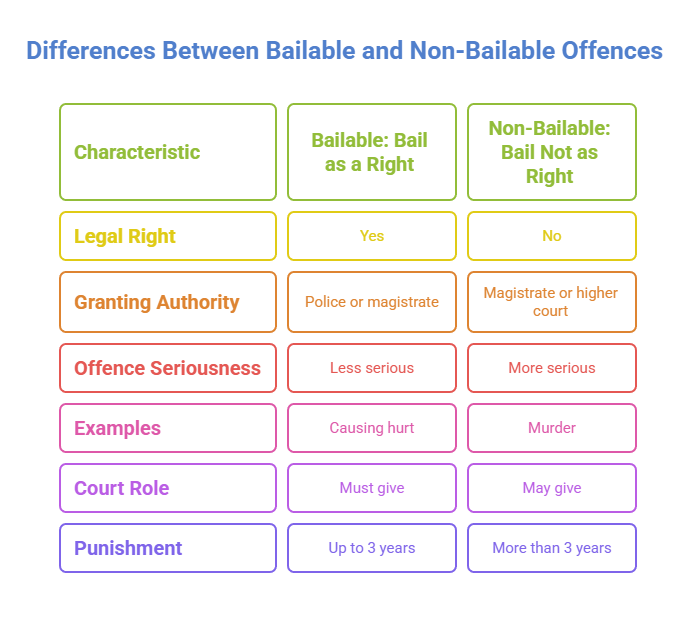Whether a person gets bail or not often depends on how the offence is classified , as bailable or non-bailable. This classification plays a key role in deciding whether an accused person should be released from custody while their case is pending in court.
This blog explains the meaning of bailable and non-bailable offences, the legal provisions behind them, and the major differences between the two.
What Are Bailable Offences?
A bailable offence is one where the person who is arrested has a legal right to be released on bail. This means that if someone is arrested for such an offence, the police or the court must grant bail, provided the accused agrees to follow the required conditions (like signing a bail bond or providing sureties).
Legal Basis
According to Section 2(a) of the Code of Criminal Procedure, 1973 (CrPC) [Section 2 (1) (b) of Bharatiya Nagarik Suraksha Sanhita], bailable offences are those listed as “bailable” in the First Schedule of the CrPC [BNSS].
Common Examples of Bailable Offences
- Voluntarily causing hurt (Section 323, IPC and Section 115 of BNS)
- Assault without grave and sudden provocation (Section 352, IPC and Section 131 of BNS)
- Public nuisance (Section 268, IPC and Section 270 of BNS)
- Misconduct in public by a drunken person (Section 510, IPC and Section 355 of BNS)
These offences are generally less serious and usually carry a punishment of three years or less.
What Are Non-Bailable Offences?
A non-bailable offence is more serious. In these cases, the accused does not have an automatic right to bail. It is up to the court to decide whether or not bail should be granted, after looking at the facts of the case.
Legal Basis
Non-bailable offences are those which are not listed as bailable in the First Schedule of the CrPC.
Common Examples of Non-Bailable Offences
- Murder (Section 302, IPC and Section 101 of BNS)
- Rape (Section 376, IPC and Section 64 of BNS)
- Kidnapping for ransom (Section 364A, IPC and Section 140 of BNS)
- Dowry death (Section 304B, IPC and Section 80 of BNS)
These offences are very serious, and the punishment is usually more than three years, including life imprisonment or even the death penalty in some cases.
In non-bailable offences, the court looks at several factors before granting bail:
- How serious is the crime?
- Is there a chance the accused might run away?
- Can the accused influence or threaten the witnesses?
- Is there enough evidence against the accused?
- Has the accused committed any crimes in the past?
If the court feels that the accused can be trusted and will not misuse the bail, it may grant bail with certain conditions, like:
- Not leaving the city without permission
- Coming to the police station regularly
- Not contacting the victim or witnesses
Key Differences Between Bailable and Non-Bailable Offences

Conclusion
In summary, offences in India are classified as either bailable or non-bailable. If the offence is bailable, the accused has the right to get bail easily. But for non-bailable offences, the accused must ask the court for bail, and it is up to the court to decide. However, bail is not guaranteed in all cases. Courts carefully weigh the rights of the accused against the safety of society and the interests of the victim before granting bail.




